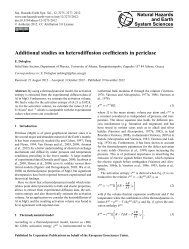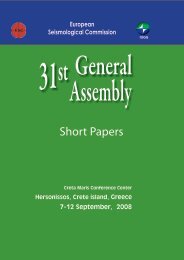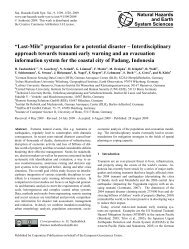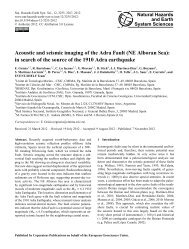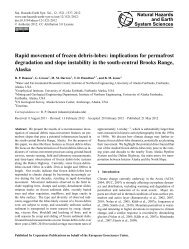Concept study of radar sensors for near-field tsunami early warning
Concept study of radar sensors for near-field tsunami early warning
Concept study of radar sensors for near-field tsunami early warning
Create successful ePaper yourself
Turn your PDF publications into a flip-book with our unique Google optimized e-Paper software.
1962 T. Börner et al.: <strong>Concept</strong> <strong>study</strong> <strong>of</strong> <strong>radar</strong> <strong>sensors</strong> <strong>for</strong> <strong>near</strong>-<strong>field</strong> <strong>tsunami</strong> <strong>early</strong> <strong>warning</strong><br />
Table 2. NESTRAD per<strong>for</strong>mance at <strong>near</strong> and far range.<br />
Wave<strong>for</strong>m Parameters far range <strong>near</strong> range<br />
Incidence angle 70 ◦ –80 ◦ 20 ◦<br />
σ 0 −30 dB −20 dB<br />
PRF 800 Hz 2 kHz<br />
Pulse width 1.25 ms 0.5 ms<br />
Peak power 100 W 1 W<br />
Bandwidth 150 MHz 150 MHz<br />
Duty cycle 100% FMCW 100% FMCW<br />
SNR 13 dB 40 dB<br />
Range resolution 1 m 3 m<br />
Azimuth resolution 2000 m 100 m<br />
3.4 ATI (along-track interferometry) mode and SAR<br />
(synthetic aperture <strong>radar</strong>)<br />
Considering the airship plat<strong>for</strong>m to be moving, rather than<br />
being stationary, <strong>of</strong>fers additional possibilities <strong>of</strong> operating<br />
the <strong>radar</strong>. With a li<strong>near</strong> movement <strong>of</strong> the plat<strong>for</strong>m along the<br />
antenna aperture (azimuth) a much larger antenna aperture<br />
can be synthesized, resulting in the typical high-resolution<br />
SAR imaging mode, which is used by almost all the current<br />
remote-sensing <strong>radar</strong> systems. Thus, assuming an aperture<br />
length <strong>of</strong> 10 m and a signal bandwidth <strong>of</strong> 150 MHz, the spatial<br />
resolution would be around 5 m in azimuth (flight direction)<br />
and 1 m in range (<strong>radar</strong> look direction), independent <strong>of</strong><br />
the sensor height above ground. The SAR mode, however,<br />
is not a good candidate <strong>for</strong> ocean monitoring, since it requires<br />
coherent summation <strong>of</strong> <strong>radar</strong> signals over the whole<br />
length <strong>of</strong> the synthetic aperture. At the low speed <strong>of</strong> an airship<br />
(∼50 m/s), building up the synthetic aperture requires<br />
acquisition time in the order <strong>of</strong> seconds, whereas the correlation<br />
length <strong>of</strong> ocean wave movement is in the order <strong>of</strong> milliseconds.<br />
SAR imaging, in this case, makes only sense over<br />
solid earth targets, which stay coherent over longer periods<br />
<strong>of</strong> time.<br />
Coming back to <strong>tsunami</strong> detection, the movement <strong>of</strong> the<br />
plat<strong>for</strong>m also opens up the opportunity <strong>of</strong> using along-track<br />
interferometry (ATI) to measure velocities <strong>of</strong> ground targets<br />
and thus also orbital velocities <strong>of</strong> ocean waves. The principal<br />
<strong>of</strong> ATI is to use two antennas at slightly different positions in<br />
the along-track (flight-) direction. If a target is moving in the<br />
radial direction (<strong>radar</strong> look direction), the Doppler spectra<br />
at the two antennas will be different and, with this difference,<br />
the radial velocity component can be estimated. The<br />
details <strong>of</strong> ATI and ground moving target indication (GMTI)<br />
can be found in (Sharma, 2004). With regard to <strong>tsunami</strong> detection<br />
it is particularly important to know, whether the expected<br />
orbital velocities can be resolved by ATI techniques<br />
or not. The minimal resolvable radial target velocity vmin<br />
depends on the velocity <strong>of</strong> the plat<strong>for</strong>m vP, the <strong>radar</strong> wave-<br />
length λ and the length <strong>of</strong> the antenna aperture L. In order<br />
to generate two separate antennas in along-track with the actual<br />
NESTRAD design, the 10 m phased array antenna can<br />
be electronically divided into two smaller antennas with the<br />
length <strong>of</strong> 5 m each, which would then yield a minimal resolvable<br />
velocity <strong>of</strong><br />
vmin = λvP<br />
= 0.025m = 2.5cm,<br />
(7)<br />
2L s s<br />
assuming a plat<strong>for</strong>m velocity <strong>of</strong> 50 m/s. Since 2.5 cm/s is<br />
in the range <strong>of</strong> a large <strong>tsunami</strong>, the accuracy would have to<br />
be increased <strong>for</strong> a small <strong>tsunami</strong>, e.g. by increasing the aperture<br />
L. Un<strong>for</strong>tunately this is not the only limiting factor <strong>for</strong><br />
ATI over the ocean. In order to enable sufficiently coherent<br />
data <strong>for</strong> resolving the required ocean currents, the time<br />
lag between the two ATI acquisitions has to be in the order<br />
<strong>of</strong> the decorrelation time, i.e. milliseconds. The distance d<br />
<strong>of</strong> the two individual antenna phase centers with respect to<br />
correlation time τ corr and plat<strong>for</strong>m velocity vP is given by<br />
(Romeiser, 2000)<br />
d = τcorr ·vP. (8)<br />
As <strong>for</strong> the a<strong>for</strong>ementioned configuration and a correlation<br />
time <strong>of</strong> 1 ms, the distance d would have to be 5 cm, which<br />
cannot be achieved by using only one electronically divided<br />
antenna. Hence the biggest problem and limiting factor is<br />
the low plat<strong>for</strong>m velocity, which cannot be significantly increased.<br />
Only expensive solutions using at least two very<br />
large antennas are able to ensure sufficient ATI per<strong>for</strong>mance<br />
<strong>for</strong> <strong>tsunami</strong> detection.<br />
Interferometry (InSAR), polarimetry (PolSAR), polarimetric<br />
SAR interferometry (PolInSAR) and also bistatic geometries<br />
(e.g. using two NESTRAD plat<strong>for</strong>ms) are further<br />
options <strong>of</strong> using the <strong>radar</strong>.<br />
4 NESTRAD’s multi-purpose approach<br />
Since a <strong>tsunami</strong> occurs only rarely, a sensor like NESTRAD<br />
would be too expensive and inefficient if designed exclusively<br />
<strong>for</strong> the purpose <strong>of</strong> <strong>tsunami</strong> <strong>warning</strong>. As already<br />
pointed out in the previous sections there are many different<br />
possibilities and options/modes to operate an advanced <strong>radar</strong><br />
instrument. Due to the fact that <strong>radar</strong> instruments nowadays<br />
can be very lightweight (easily below 50 kg if required), and<br />
that airships are able to carry huge payloads up to a few tons,<br />
there is enough space and mass budget left <strong>for</strong> arbitrary additional<br />
<strong>sensors</strong> (e.g. optical, GNSS, infrared, more <strong>radar</strong>, etc.)<br />
on the same plat<strong>for</strong>m, which could be used <strong>for</strong> many applications.<br />
Beyond the capability <strong>of</strong> quick and effective <strong>tsunami</strong><br />
detection, such a system could be able to serve <strong>for</strong> example<br />
<strong>for</strong> sea state monitoring in general, ship tracking (traffic,<br />
piracy, etc.), reconnaissance and surveillance, local weather<br />
monitoring, hurricane monitoring, volcano monitoring, flood<br />
monitoring, traffic monitoring, and as a communication relay<br />
station.<br />
Nat. Hazards Earth Syst. Sci., 10, 1957–1964, 2010 www.nat-hazards-earth-syst-sci.net/10/1957/2010/



